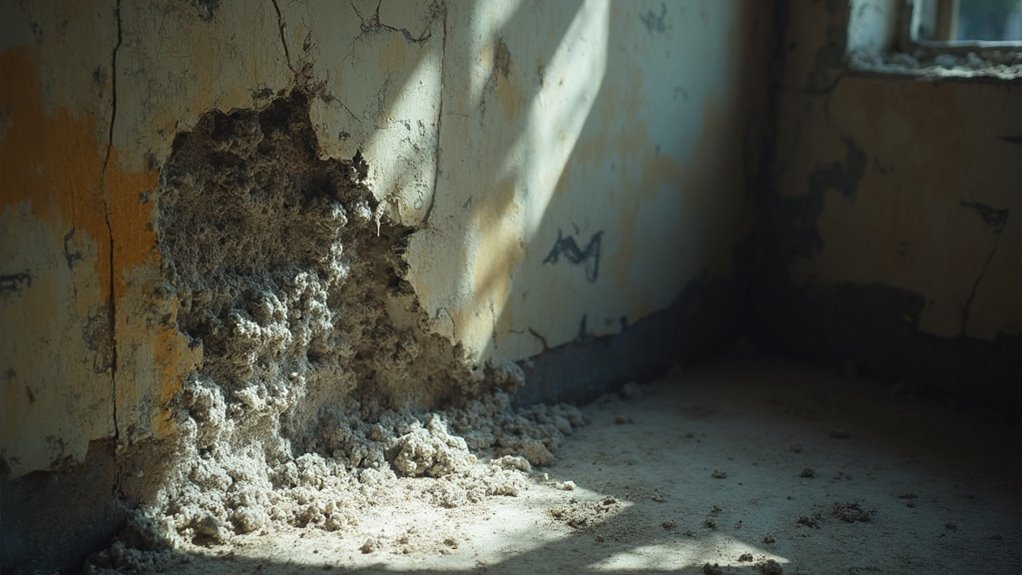Leaving asbestos untouched might feel safe, but it isn't without risks. Over time, undisturbed asbestos can deteriorate, releasing harmful fibers into the air. These fibers are especially dangerous when inhaled, potentially leading to severe diseases like lung cancer, asbestosis, and mesothelioma decades later. Even minor disturbances in your environment can increase fiber release, elevating health threats considerably. The misconception that untouched asbestos is harmless can lead to grave consequences. Regular inspections and professional evaluations are essential for managing this hidden danger effectively. Exploring further, you'll uncover important safety measures and insights into proper asbestos management.
Understanding Asbestos Risks

When it comes to understanding asbestos risks, it's imperative to recognize that the presence of asbestos alone isn't an immediate threat. Asbestos was historically used in various building materials because of its fire-resistant properties, but its dangers only emerge when these materials become damaged, releasing harmful fibers into the air. You won't develop asbestos-related diseases right away; they often manifest 20 to 50 years after exposure.
While asbestos regulations have tightened over the years, significant exposure—whether acute or chronic—still heightens your risk of developing serious health issues like lung cancer and mesothelioma. It's critical to understand that inhaling asbestos fibers can lead to conditions such as asbestosis, which causes lung scarring and breathing difficulties. Long-term exposure to asbestos is linked to a variety of serious health effects, emphasizing the need for vigilance. Furthermore, asbestos testing before renovations is essential to ensure safety and compliance with regulations.
Moreover, asbestos doesn't break down in the environment, creating long-term contamination risks. Even in cases where asbestos-containing materials seem intact, regular inspections for wear or damage are important. By grasping these risks, you can better navigate the complexities of asbestos in your surroundings and make knowledgeable choices regarding its management in line with current regulations.
The Dangers of Disturbance
When you disturb asbestos materials, you risk releasing harmful fibers into the air. These airborne fibers create significant health hazards, increasing the likelihood of serious diseases like lung cancer and mesothelioma. Understanding how even minor disturbances can lead to major health risks is essential for anyone involved in maintenance or renovations. Proper testing can help identify the presence of asbestos and guide safe handling practices.
Fiber Release Risks
Asbestos fibers pose significant health risks, particularly when materials containing them are disturbed. Even in good condition, these materials remain safe until damaged. When you engage in activities like sawing or drilling, you can inadvertently release harmful fibers into the air. Here's what you need to know about fiber release risks:
- Wear and damage on asbestos materials increase the likelihood of fiber release.
- Vibration and airflow can cause asbestos fibers to become airborne, even without direct disturbance.
- Specific materials, like resilient floor tiles and insulation, are particularly vulnerable during removal or repair.
- Improper handling during renovation can lead to significant environmental contamination.
To mitigate these risks, consider asbestos containment strategies and implement fiber monitoring systems. If you suspect asbestos in your home or workplace, it's essential to consult professionals for assessment and remediation. Remember, while undisturbed asbestos doesn't pose an immediate threat, any disturbance can lead to serious health consequences. Always prioritize safety and make well-informed choices regarding asbestos materials.
Health Hazard Creation
Disturbing asbestos-containing materials can create immediate health hazards that were previously nonexistent. When asbestos is damaged, it releases fibers into the air, posing serious risks to your health. Typically, undisturbed asbestos remains safe, but if you handle or disturb it, you can inadvertently create a significant hazard. The inhalation of these airborne fibers can lead to scarring and inflammation in the lungs, increasing your risk of diseases like lung cancer and mesothelioma.
Effective asbestos management requires a careful risk assessment to determine the condition of materials containing asbestos. If you suspect any damage, it's critical to avoid minor repairs on your own, as improper handling can worsen the risk. Instead, professional removal or repair is advised when materials are more than slightly damaged.
Health Effects of Asbestos Exposure

As you consider the health effects of asbestos exposure, it's vital to understand the long-term risks associated with inhaling these harmful fibers. Diseases like asbestosis, mesothelioma, and lung cancer can develop many years after initial exposure, often without immediate symptoms. Recognizing the specific types of illnesses linked to asbestos is important for understanding the potential dangers you or your loved ones might face.
Long-Term Health Risks
Long-term exposure to asbestos presents significant health risks that can severely impact lung function and overall well-being. When you're exposed to asbestos, you may unknowingly increase your risk of developing serious respiratory diseases over time. It's fundamental to understand the factors that contribute to these risks:
- Duration of exposure: Longer exposure increases health risks.
- Airborne asbestos levels: Higher concentrations lead to greater danger.
- Frequency of exposure: Regular contact heightens risk levels.
- Pre-existing conditions: Lung diseases can worsen effects.
Asbestos safety and exposure awareness are imperative for those who may have been exposed. The most alarming aspect is the latency period; diseases like asbestosis and lung cancer can take 15 to 30 years to manifest, meaning you might not feel the consequences until decades later. Additionally, the absence of a safe exposure threshold means even minimal contact can lead to severe health implications. Regular medical check-ups and screenings are critical for early detection. By staying informed and proactive, you can better safeguard your health against the long-term risks of asbestos exposure.
Disease Types Explained
While many people may associate asbestos exposure with a few well-known diseases, the reality is that a variety of serious health conditions can arise from this hazardous material. Asbestos toxicity leads to malignant diseases such as mesothelioma, which forms in the membranes surrounding essential organs, and lung cancer, which can develop after 15 to 35 years of exposure. Ovarian and laryngeal cancers likewise show markedly increased risks linked to asbestos.
On the non-cancerous side, conditions like asbestosis and chronic obstructive pulmonary disease (COPD) can severely impair lung function. Asbestos fibers cause inflammation and DNA damage, initiating disease mechanisms that lead to scarring and other lung complications. Pleural plaques and thickening serve as indicators of past asbestos exposure, highlighting the material's long-lasting effects.
It's imperative to understand that even minimal exposure can trigger these health issues, with a latency period that may span decades. Accordingly, recognizing the full spectrum of asbestos-related diseases is essential for those at risk, especially in occupations or environments where exposure is prevalent. Awareness can encourage proactive measures to mitigate these dangerous health outcomes.
Types of Asbestos-Related Diseases
Occasionally, individuals exposed to asbestos may develop a range of serious health conditions, categorized into non-cancerous and cancerous diseases. Understanding these asbestos diseases is essential for awareness and prevention.
Non-cancerous effects include:
- Asbestosis: A lung disease that results from inhaling asbestos fibers, leading to lung fibrosis.
- Pleural Plaques: Non-cancerous thickened areas on the pleura, indicating previous asbestos exposure.
- Pleural Effusion: A condition marked by fluid accumulation in the pleural space.
- Pleural Thickening: Scarring that causes the pleura to thicken and can restrict breathing.
On the cancerous side, asbestos exposure notably raises the risk of developing:
- Lung Cancer: Particularly concerning for smokers.
- Malignant Mesothelioma: An aggressive cancer affecting the linings of organs, directly linked to asbestos.
- Laryngeal Cancer: Cancer of the voice box associated with asbestos exposure.
- Ovarian Cancer: Exposure to asbestos is a recognized risk factor.
Recognizing these risks helps you understand the importance of addressing asbestos exposure to mitigate serious health consequences.
Primary Exposure Pathways

Asbestos exposure occurs primarily through three pathways: airborne, ingestion, and dermal contact. Understanding these exposure pathways is essential for effective risk assessment. Airborne exposure is the most significant concern, as it happens when asbestos-containing materials are disturbed, releasing fibers into the air. Common scenarios include renovations, construction activities, and even environmental disturbances in areas with asbestos-bearing rocks. You might unknowingly inhale fibers while working alongside someone handling asbestos or during home renovations.
Ingestion often follows inhalation, as fibers can be cleared from the lungs and swallowed. Furthermore, drinking contaminated water or consuming biota like clams can lead to asbestos ingestion, even though significant exposure from water is uncommon because of regulatory standards.
Dermal contact, while less common, can occur when handling asbestos directly. Even though modern safety measures, including personal protective equipment, have reduced these risks, historical exposure provides insight into the potential dangers.
Regardless of the pathway, it's clear that disturbances increase the risk of exposure. By recognizing these pathways, you can better assess potential risks and take appropriate precautions to protect yourself and others.
Long-Term Health Consequences
Understanding the long-term health consequences of asbestos exposure is crucial for anyone who may have been in contact with this hazardous material. The risks associated with asbestos aren't immediate; they can take years to manifest, often emerging 10 to 40 years after exposure. Asbestos regulations have evolved, yet historical usage still leaves many vulnerable to its effects.
Consider the following health issues linked to asbestos exposure:
- Asbestosis: A chronic lung disease leading to permanent tissue damage.
- Lung Cancer: A fatal condition that originates in respiratory tissues.
- Mesothelioma: A deadly cancer affecting the membranes around the lungs and abdomen.
- Pleural Plaques: Changes in lung membranes that may not cause serious issues but indicate exposure.
Long-term exposure, even at low levels, greatly increases the risk of chronic conditions. Furthermore, if you smoke, the combination with asbestos exposure further escalates your risk of lung cancer. The cumulative nature of exposure means that even past contact can haunt you with severe health consequences. Understanding these risks is crucial for taking appropriate action and protecting your health.
Safe Practices for Asbestos

The long-term health risks associated with asbestos exposure highlight the significance of adopting safe practices when handling this hazardous material. When you engage in asbestos handling, you must wear appropriate personal protective clothing and equipment to minimize health risks. Utilizing non-powered hand tools is vital as it helps reduce dust generation, leading to coarser waste chips.
Before starting any work, wet down materials to prevent fiber release into the air. Pull out nails first to remove sheeting with minimal breakage, and avoid using power tools, as they can increase fiber release. Moreover, keep household members, visitors, and pets away from the work area until you've completed the job and cleaned up thoroughly.
During cleanup, cover the ground with heavy-duty plastic sheeting to catch any dust and debris. Use wet rags or a HEPA-filter vacuum cleaner to remove residues. Finally, carefully package any asbestos waste in double layers of polythene sheeting, label them as "ASBESTOS WASTE," and dispose of them at an EPA-authorized site. These protective measures are vital for ensuring safety while handling asbestos.
Importance of Regular Inspections
Regular inspections are essential for identifying damage to asbestos-containing materials before it escalates into a serious health hazard. By ensuring safe conditions in your environment, you not only protect yourself and others but likewise comply with legal obligations. Staying proactive about inspections can greatly mitigate risks associated with asbestos exposure.
Identifying Damage Early
Conducting regular inspections is crucial for identifying potential asbestos damage before it becomes a serious health risk. Early detection through visual surveillance can prevent asbestos materials from deteriorating and releasing harmful fibers. By being proactive, you not only protect your health but likewise comply with regulations.
Here are some key points to reflect on:
- Identify asbestos sources: Especially important in non-housing facilities and unoccupied spaces.
- Annual surveillance: Required to monitor the conditions of asbestos-containing materials (ACM) and potentially asbestos-containing materials (PACM).
- Professional sampling: Should be conducted by EPA/AHERA-accredited inspectors for accurate assessment.
- Labeling: Properly label ACM and PACM to inform and protect occupants.
Ignoring these inspections can lead to severe health hazards, including asbestosis, lung cancer, and mesothelioma. The risks increase considerably if damaged asbestos isn't managed. By prioritizing regular inspections, you can guarantee early detection of any issues and take necessary steps to mitigate potential dangers. Remember, managing asbestos is not just about compliance; it's about safeguarding your health and the health of those around you.
Ensuring Safe Conditions
Guaranteeing safe conditions within a property hinges on consistent inspections that identify and manage asbestos-containing materials (ACMs). Regular inspections are vital for maintaining compliance with regulations and safeguarding health. These inspections help you detect any damage or deterioration of ACMs early, allowing for prompt remediation. Adhering to established inspection protocols guarantees that you're aware of the state of your property and can take necessary actions before issues escalate.
Factors like building age, occupancy, and usage patterns influence how frequently you should conduct asbestos surveys. For instance, older buildings or those undergoing renovations require more frequent assessments to monitor the integrity of ACMs. Neglecting these inspections can lead to severe legal and financial consequences, including hefty fines and costly lawsuits from health claims.
Professional asbestos management entails keeping an updated asbestos register, conducting air monitoring tests, and guaranteeing clear access controls around hazardous areas. By implementing these best practices, you not only comply with regulations but likewise protect the health of your tenants and workers. Regular inspections are not just a legal obligation; they are a fundamental aspect of maintaining a safe and sustainable property.
Professional Remediation Options

When dealing with asbestos risks, understanding professional remediation options is vital for maintaining safety in your environment. There are primarily two remediation techniques: repair and removal. Repair is often cheaper but could complicate future removals, while removal should be a last resort unless mandated by regulations.
Here's a quick overview of each method:
- Repair Techniques: This includes sealing (encapsulation) to bind asbestos fibers or covering (enclosure) to prevent their release.
- Removal: Only trained and accredited professionals should handle this, as improper removal can escalate exposure risks.
- Professional Certifications: Ensuring that the contractors you hire have the necessary certifications is important for safe practices.
- Separate Companies: It's advisable to hire different companies for inspection and abatement to prevent conflicts of interest.
Myths About Untouched Asbestos
Myths surrounding untouched asbestos often lead to dangerous misconceptions about its safety. Many believe that leaving asbestos undisturbed is a foolproof method to avoid health risks. Nevertheless, this is a classic example of myth disproving. Untouched asbestos can still deteriorate over time, releasing harmful fibers into the air, especially through regular home activities that stir up dust.
You might likewise think that the mere presence of asbestos isn't a hazard unless disturbed, but the condition of the material is essential in evaluating risk. Even intact materials can suffer damage owing to wear and tear, potentially leading to fiber release. It's critical to understand that not all asbestos materials are similarly hazardous; the type and condition of the asbestos play significant roles in determining the risk.
While disturbing asbestos can certainly create a health hazard, simply leaving it alone isn't always the safest option. A professional evaluation may be necessary to evaluate and manage potentially deteriorating asbestos. Being informed about these asbestos misconceptions can help you make better decisions regarding safety in your home.
Frequently Asked Questions
Can I Paint Over Asbestos-Containing Materials Safely?
You can paint over asbestos-containing materials safely if you guarantee proper asbestos encapsulation first. Using suitable sealants and protective paint prevents fiber release, minimizing health risks while allowing you to achieve your desired aesthetic.
How Can I Tell if Asbestos Is Present in My Home?
To identify asbestos in your home, combine visual identification with professional asbestos testing. Look for aging materials, unusual textures, or damage. If you suspect its presence, consult a licensed expert for accurate assessment and guidance.
What Should I Do if I Accidentally Disturb Asbestos?
If you accidentally disturb asbestos, stop work immediately, evacuate the area, and seal it off. Follow emergency procedures, report the incident, and seek professional help for asbestos safety to minimize health risks effectively.
Are There Any Legal Requirements for Asbestos Management?
You might think asbestos management's straightforward, but it's not. Asbestos regulations demand detailed management plans. Duty holders must identify, maintain, and guarantee proper removal of asbestos, adhering strictly to the Control of Asbestos Regulations 2012.
How Does Weather Affect the Stability of Asbestos Materials?
Weather greatly impacts asbestos deterioration. Environmental factors like temperature fluctuations and high humidity accelerate material breakdown, increasing the risk of fiber release. Understanding these effects is essential for managing asbestos and ensuring safety in affected areas.
